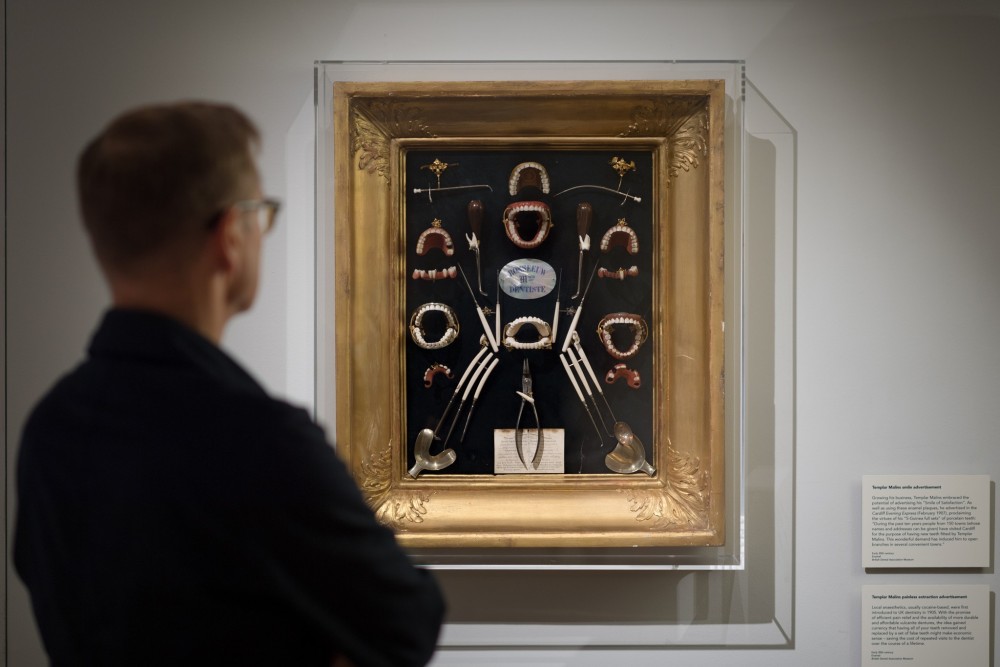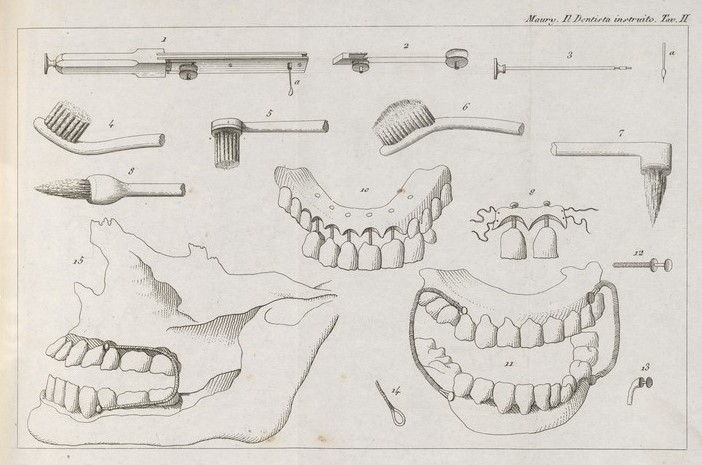

PhD student Issy Staniaszek explores the relationship between dentistry and villainy in Braddon's 1867 sensation novel.
Although most famous as the author of Lady Audley’s Secret (1862), Mary Elizabeth Braddon (1835-1914) authored more than ninety novels and edited two periodicals, experimenting with various genres during her lifetime.[1] In Birds of Prey (1867), Braddon employs many of the tropes which had secured her reputation as a leader of the sensation genre. The novel’s plot centres around the contested inheritance of a fortune, which inspires two brothers (a dentist-turned-stockbroker and a lawyer) to go to the extremes of their professions in trying to attain it. The elder brother, Philip Sheldon, becomes the villain of the novel and its sequel, Charlotte’s Inheritance (1868). His qualifications as a medical practitioner grant him access to the knowledge of poisons he requires to murder his rich and naïve friend, Tom Halliday, and manipulate his widow into marrying him. In the sequel, he attempts to murder his stepdaughter to gain her inheritance.
As with many sensation novels, appearances in Birds of Prey are rarely what they seem. The novel opens with a detailed description of Philip Sheldon’s home practice: ‘the very pink and pattern of respectability’ and Sheldon himself is assumed to be just as respectable (‘he was on the sunnier side of thirty, a bachelor, and very good-looking’).[2] However, his neighbours voice the concerns of the reader when they ask ironically ‘how long all that outward semblance of prosperity would last’.[3]

In the context of medical precarity in the 1860s, speculation over how long prosperity would last takes on a barbed edge: the cost of establishing a practice could bankrupt a young medical practitioner if he was unable to secure enough patients quickly. [4] Dentistry, which had only relatively recently begun to be seen as a separate branch of medicine, was a particularly precarious choice of profession. In the eighteenth century, French ‘chirurgiens-dentistes’ began to treat British mouths, and English practitioners eventually adopted the name ‘dentist’, signifying a move away from the barber-surgeon or brutal-sounding ‘tooth-puller’ towards dentistry as a medical profession.[5] The first formal qualification for dentistry appeared in Britain in 1859, but the dental register was not created until 1878, so for Braddon in the late 1860s, dentistry remained a somewhat undefined and unregulated profession.[6]
I think it is precisely this ambiguity which inspired Braddon in the creation of her villain. Even today, for many people dentistry still inspires fearful imagery of pain and suffering. Braddon deftly satirizes this experience:
Pedestrians of agonised aspect, with handkerchiefs held convulsively before their mouths, were seen to rush wildly towards the dentist’s door, then pause for a moment, stricken by a sudden terror, and anon feebly pull the handle of an inflexible bell..[7]
In evoking the fact that patients rarely attended the dentist unless they were already in considerable pain, Braddon immediately establishes Sheldon’s house as a place where, despite its respectable appearance, pain is inflicted.
In addition to the general patient experience of pain, Braddon implies Sheldon’s nefarious character through his employment of advertising techniques often associated with irregularity and quackery:
The new-comer was evidently of an active and energetic temperament, for within three days of his arrival the brass-plate on his street-door announced his profession, while a neat little glass-case, on a level with the eye of the passing pedestrian, exhibited specimens of his skill in mechanical dentistry, and afforded instruction and amusement to the boys of the neighbourhood, who criticised the glistening white teeth and impossibly red gums, displayed behind the plate-glass with a like vigour and freedom of language.[8]
While ostensibly displaying his skill as a dentist, Sheldon’s window immediately becomes a source of horrified amusement for the local children. As curator James Peto remarked of a gilt-framed window display for a Belgian dentist recently displayed in the Wellcome Collection’s ‘Teeth’ exhibition, the display of realistic (if man-made) body parts, particularly those associated with pain, no matter how beautiful or impressive, generally inspires horror rather than admiration: 'It’s showing off, saying, "I can give you a wonderful set of teeth". But if you look closely the dentures on show are really hideous things, which means it takes on the air of a surreal artwork'.[9]

Braddon further exploits the horrific potential of the relatively new technology of mechanical dentistry once the narrative follows Philip Sheldon inside his home practice. While his patients ‘left it as much pleased with Mr. Sheldon as one can be with a man at whose hands one has just undergone martyrdom, and circulated a very flattering report of the dentist’s agreeable manners and delicate white handkerchief’, when he is alone, the narration refers to the location and materials of the dentist’s profession in much less flattering terms:
he lit a taper, and went down to the professional torture-chamber. The tall horsehair chair looked unutterably awful in the dim glimmer of the taper, and a nervous person could almost have fancied it occupied by the ghost of some patient who had expired under the agony of the forceps.[10]
In evoking images of torture and ghostly apparitions in the candlelight, Braddon employs the language of Gothic horror to create an atmosphere in which the reader could comfortably imagine terrible events occurring. Sheldon’s consulting room is repeatedly referred to as a ‘torture-chamber’. The first example, quoted above, occurs at the point that he consults the medical texts which inspire him to attempt murder by poisoning. Thus, the connection is made explicit; Braddon makes the medical space into one where pain and even death at the hands of the dentist are entirely possible.

Further, the scientific experimentation which medical publications lauded is interpreted by those outside the profession as the epitome of horror. When Philip Sheldon’s brother, George, visits to discuss the mysterious illness of their friend (who the reader deduces that Philip is poisoning), Braddon explicitly evokes the imagery of the Gothic mode:
He went to look for his brother, who he found in the torture-chamber, busied with some mysterious process in connection with a lump of plaster-of-Paris, which seemed to be the model of ruined battlements in the Gothic style.[11]
Through George’s eyes, the materials of medical science are transformed into the kind of architecture one would encounter as the backdrop to a Gothic novel. Braddon shows how medical objects (perhaps particularly dental instruments) can be interpreted as objects of horror by the inexpert public.
When asked if he is working on a patient order, Philip Sheldon replies, “No, I’m not working to order; I’m only experimentalising”.[12] Braddon’s narration makes it clear that this scientific experimentation should be viewed as something concerning.
“You’re rather fond of experiments, I think, Phil,” said George, seating himself near the table at which his brother was working under the glare of the gas. The dentist looked very pale and haggard in the gas-light, and his eyes had the dull sunken appearance induced by prolonged sleeplessness. George sat watching his brother thoughtfully for some time, and then produced his cigar-case. “You don’t mind my smoke here?” he asked, as he lighted a cigar.
“Not at all. You are very welcome to sit here, if it amuses you to see me working at the cast of a lower jaw.”
“O, that’s a lower jaw, is it? It looks like the fragment of some castle-keep”.[13]
The dentist’s unhealthy appearance is portrayed as a direct consequence of his ‘experimentalising’. The reader knows what George Sheldon is beginning to deduce, that Philip is conducting another, deadly, ‘experiment’ on their friend Tom Halliday.
In Birds of Prey, Braddon exploits the fear (voiced by medical men and patients alike), that medicine which treated patients as scientific cases rather than consulting the whole patient could lead to a dehumanised and disconnected approach. Sensation novelists frequently pitted what was perceived as the unemotional new scientific approach to medicine against the more traditional, patient-focused approach of the past. By choosing the emerging field of mechanical dentistry, a medical field traditionally associated with quackery and pain, and newly associated with scientific and mechanical ‘experimentalising’, Braddon ramps up this tension, playing on the emotional responses of the reader, and creating a truly sinister villain.
For more on medicine, surgery and emotion in sensation fiction, see Alison Moulds' post on Wilkie Collins' Poor Miss Finch.
[1] Jennifer Carnell, The Literary Lives of Mary Elizabeth Braddon (Hastings: The Sensation Press, 2000), p.1.
[2] Mary Elizabeth Braddon, Birds of Prey (London: Ward, Lock and Taylor, 1868), p.2; p.6.
[3] Ibid., p.5.
[4] Alannah Tomkins, Medical Misadventure in an Age of Professionalisation, 1780-1890 (Manchester: Manchester University Press, 2017), p.274.
[5] Colin Jones, ‘French Dentists and English Teeth in the Long Eighteenth Century: A Tale of Two Cities and One Dentist’ in Roberta Bivins and John V. Pickstone (eds), Medicine, Madness, and Social History: Essays in Honour of Roy Porter (Palgrave, 2007), pp. 73-89.
[6] Saul Kamen, Malvin E. Ring, et al, ‘Dentistry’, Encyclopædia Britannica, https://www.britannica.com/science/dentistry (Jan 2018).
[7] Braddon, Birds of Prey, p.5.
[8] Ibid., p.4.
[9] Gwen Smith, ‘Inside the Minds of Teeth’s Two Curators, James Peto and Emily Scott-Dearing’, Stories, https://wellcomecollection.org/articles/W1HPDCYAACgAlLN2 (25 July 2018) [accessed 30 Jan 2019].
[10] Braddon, Birds of Prey, p.21.
[11] Ibid., p.44.
[12] Ibid., p.45.
[13] Ibid.